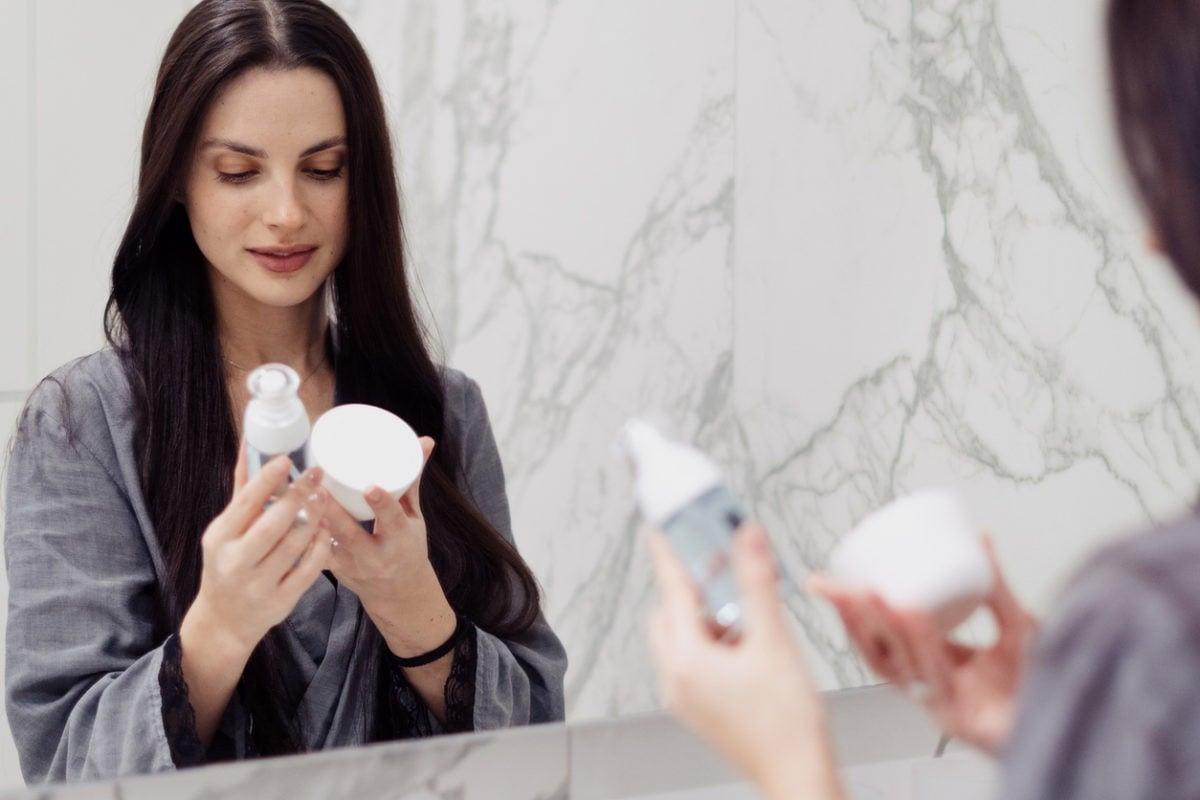What are AHAs?
Alpha-hydroxy acids (AHAs) are natural compounds derived from various sources like fruits, sugar cane, or milk. In skincare products, AHAs work to dissolve the “glue” that holds dead cells to the skin’s surface. This process is called exfoliation and is one of the most effective methods to eliminate dead, dull skin and reveal brighter, healthier skin.
AHAs are called acids because they have a low pH (<4). The skin’s natural pH is slightly acidic, around 4.7 to 5.75. Alpha-hydroxy acids lower the pH of the skin even more, which makes it easier to dissolve the bonds between dead skin cells. This process of exfoliation is most effective when the skin has an acidic pH because it allows AHAs to break down the substances holding the dead cells together so they can be shed off more easily.
The word “acid” shouldn’t scare you. Alpha-hydroxy acids are formulated to be safe and not affect the pH of the skin to a level that exposes you to risks. Plus, AHAs are humectants, which means they attract moisture to the skin.[1] Regularly using AHAs can lead to smoother, brighter skin with reduced signs of aging and sun damage.
Understanding different AHAs
The most common AHAs in skincare products are glycolic acid (derived from sugar cane), lactic acid (derived from milk), malic acid (derived from apples and cherries), and citric acid (derived from lemons).
While all alpha-hydroxy acids exfoliate the skin, they do so with varying degrees of intensity. This is because AHAs have different molecular weights, which affect how they penetrate the skin.
In general, substances with a small molecular size penetrate the skin better, and those with a high molecular weight penetrate less. For example, glycolic acid is considered the strongest AHA because it has the smallest molecular weight, and lactic acid is gentler because it has a larger molecular weight. This also affects their potency: glycolic acid is more effective but also more irritating, while lactic acid is more hydrating and gentle.
Moreover, all AHAs are water-soluble, so they can only work on the epidermis, the surface layer of the skin. Since they are not soluble in oils, they cannot penetrate the fat layer of the skin.
How AHAs work
- AHAs exfoliate the surface level of the skin. This accelerates cell turnover, or easier to say, the skin’s natural renewal process. As dead cells are shed off, the skin becomes smoother, brighter, and clearer.
- Once they penetrate the skin, AHAs can also trigger collagen production.[2] In the case of wound healing, more collagen is necessary to repair the damaged tissues; in anti-aging skincare, more collagen is needed to restore skin elasticity.[3]
- Glycolic and lactic acid have antibacterial and anti-inflammatory properties. That means they can reduce inflammation and relieve acne-prone skin.[4]
- Alpha-hydroxy acids are humectants. They draw moisture from the air into the skin. With correct use, they can restore hydration to dry skin and reduce tightness and flaking. However, use them carelessly and they can dehydrate and irritate your skin. We’ll explain more about that later in the article.
Read more: What’s The Difference Between Lactic Acid and Glycolic Acid
Are AHAs safe for the skin?
According to the Cosmetic Ingredient Review, glycolic and lactic acids are safe for use in cosmetics at concentrations of no more than 10% and pH no higher than 3.5.[6] However, they can cause some side effects, especially if your skin is sensitive or you’ve never used AHAs before.
- It’s normal to experience some redness and flaky skin after using AHAs. That means they’re working. Take a break from AHAs until your skin recovers. But if your skin remains extremely dry, inflamed and irritated even after taking a break from AHAs, you need to lower the concentration or frequency of your exfoliation.
- AHAs make the skin sensitive to sunlight, so it’s crucial to use sunscreen.
- AHAs can cause what is known as skin purging, a condition where your skin might temporarily break out more as it gets rid of dirt, oil, and dead cells. Purging looks like a mix of whiteheads, blackheads, papules, and pustules, usually in areas where you normally get acne, and it happens because your skin is adjusting to the new product. This increase in breakouts is generally short-lived and your skin should return to normal after a week or so. If it doesn’t, consult a dermatologist.
Who should use AHAs?
Regardless of your age or skin condition, you can use AHAs as long as they don’t cause severe redness, dryness, or irritation.
If you are new to using acids, start with a milder concentration of acids (<5%) and gradually increase the concentration as your skin adjusts to the exfoliation. For example, if your skin is problematic, you can use a glycolic acid toner for the first month to build tolerance, then upgrade to stronger products such as serums and peels with a 10% concentration.
Alpha-hydroxy acids are most effective for age-related problems such as fine lines, wrinkles, and dark spots. Experts also recommend AHAs for dull, dry skin and to smooth rough, uneven texture.
How to use AHAs
- Only use AHAs at night, as they can make skin sensitive to sunlight.
- First wash your face with a mild cleanser.
- Before using AHAs on your face, do a patch test on a small area of your skin to check for adverse reactions.
- Apply the AHA product gently and evenly across your face, avoiding the eye area and other sensitive areas.
- Allow the AHA to absorb for about 10-20 minutes. Do not rinse immediately unless the product instructions say otherwise.
- Use a rich, occlusive moisturizer to lock in hydration.
- Follow with a broad-spectrum sunscreen in the morning.
What else:
- Start with lower concentrations and infrequent use (once or twice a week). Gradually increase frequency based on your skin’s tolerance.
- Adjust frequency and concentration based on how your skin reacts.
- No retinol, salicylic acid, or benzoyl peroxide. Don’t use these ingredients in the same session as AHAs to avoid over-exfoliating your skin. When you use these ingredients, alternate them with AHAs on different nights.
- Monitor your skin for irritation, redness, peeling, or sensitivity. If irritation occurs, reduce the frequency or concentration of AHAs.
- Adapt your skincare routine based on seasonal changes, as the skin can be more sensitive to AHAs in extreme weather like the cold winters.
Read Next: The 10 Best Glycolic Acid Peels
You ask, we answer
- Can you use AHAs with retinol?
It’s fine to use AHAs with retinol, either on alternative days or use acids in the morning and retinol in your nighttime routine.
- Can you use AHAs with vitamin C?
Because AHAs and vitamin C are formulated at an acidic pH, you should use them at different times (vitamin C in the morning, AHAs at night) or on alternative days.
- Can you use AHAs with BHAs?
It’s safe to use AHAs and BHAs together as long as you don’t have problematic skin. They team up well to work on the skin’s surface and beneath to remove the buildup of dead cells and unclog pores.
- Can you use AHAs on sensitive skin?
It’s ok to use AHAs on sensitive skin if the product has a low concentration of acids. You can gradually work up to stronger formulas as your skin builds tolerance.
- Can you use AHAs on acne-prone skin?
AHAs are excellent for acne-prone skin due to their anti-inflammatory and exfoliating properties. They are good at cleansing pores, which is where dead cells and bacteria accumulate, the ones that make pimples arise.
Women’s Concepts uses reliable sources, including dermatologists’ insights, clinical trials, and scientific journals, to find accurate information and support all the facts shared in our articles. All statements and claims have clear and legit references. Read our editorial policy to learn more about our sources of information, our process of researching and fact-checking the content, and how our team strives to keep all articles updated, completed, and trustworthy.
- Purnamawati S, Indrastuti N, Danarti R, Saefudin T. The Role of Moisturizers in Addressing Various Kinds of Dermatitis: A Review. Clin Med Res. 2017 Dec, https://www.ncbi.nlm.nih.gov/pmc/articles/PMC5849435/
- Kim SJ, Park JH, Kim DH, Won YH, Maibach HI. Increased in vivo collagen synthesis and in vitro cell proliferative effect of glycolic acid. Dermatol Surg. 1998 Oct;24, https://pubmed.ncbi.nlm.nih.gov/9793513/
- Perricone NV, DiNardo JC. Photoprotective and antiinflammatory effects of topical glycolic acid. Dermatol Surg. 1996 May;22, https://pubmed.ncbi.nlm.nih.gov/8634805/
- Garg T, Ramam M, Pasricha JS, Verma KK. Long term topical application of lactic acid/lactate lotion as a preventive treatment for acne vulgaris. Indian J Dermatol Venereol Leprol. 2002 May-Jun, https://pubmed.ncbi.nlm.nih.gov/17656910/
- Walter P Smith, Epidermal and dermal effects of topical lactic acid, Journal of the American Academy of Dermatology, Volume 35, Issue 3, Part 1, 1996, Pages 388-391, https://www.sciencedirect.com/science/article/abs/pii/S0190962296906027
- The U.S. Food & Drug Administration, Guidance for Industry: Labeling for Cosmetics Containing Alpha Hydroxy Acids





